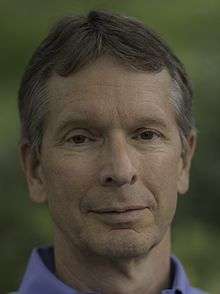Donald D. Hoffman
| Donald D. Hoffman | |
|---|---|
 | |
| Born |
December 29, 1955 San Antonio, Texas, USA |
| Alma mater |
UCLA (B.A. 1978) M.I.T. (Ph.D. 1983) |
| Scientific career | |
| Fields | Cognitive science |
Donald David "Don" Hoffman (born December 29, 1955) is an American quantitative psychologist and popular science author. He is a Professor in the Department of Cognitive Sciences at the University of California, Irvine, with joint appointments in the Department of Philosophy, the Department of Logic and Philosophy of Science, and the School of Computer Science.
Hoffman studies consciousness, visual perception and evolutionary psychology using mathematical models and psychophysical experiments. His research subjects include facial attractiveness, the recognition of shape, the perception of motion and color, the evolution of perception, and the mind-body problem. He has co-authored two technical books: Observer Mechanics: A Formal Theory of Perception (1989) offers a theory of consciousness and its relationship to physics; Automotive Lighting and Human Vision (2005) applies vision science to vehicle lighting. His book Visual Intelligence: How We Create What We See (1998) presents the modern science of visual perception to a broad audience. His new book, tentatively titled Do We See Reality?, to appear at the end of 2017, expands on his 2015 TED Talk and explains how our perceptions have evolved to hide reality from us.
Hoffman has won the Distinguished Scientific Award from the American Psychological Association, the Troland Research Award of the National Academy of Sciences, and the Rustum Roy Award of the Chopra Foundation. He is slated to deliver the Leibniz Public Lecture at the Leibniz Universität Hannover in 2017. He has served on the editorial board of the journal Cognition, and contributed for several years to the Edge Annual Question. A complete list of his activities and publications is given in his vita and homepage.
Biography
Hoffman was born in an army hospital at San Antonio, Texas, in 1955. His parents are David and Loretta Hoffman. His father was an army private, went on to earn a Master of Science degree in chemistry on the G.I. Bill, and worked as a quality assurance engineer. He later became an ordained minister and earned a Master of Arts degree in counseling. Hoffman’s mother was first a homemaker, earned a Bachelor of Arts degree in microbiology, became a computer programmer writing software for banks, and earned a Master of Arts degree in counseling. Both are active in counseling. Hoffman has two younger siblings. His brother Jim is the business operations manager for the Earth Science and Technology Directorate at JPL/ CalTech/NASA in Pasadena, California, which builds many of the Earth Science satellites and instruments for NASA and NOAA. His sister Cheryl is a homemaker and home-school teacher. Hoffman married Rebecca Holman in 1977 and they divorced in 1985. His wife, Geralyn Souza, whom he married in 1986, is an artist, graphic designer and award-winning photographer. Hoffman is an amateur photographer with a Flickr page. He has a daughter, Melissa Louise Nunez, who is a lawyer, a son-in law, Jay Nunez, also a lawyer, and three grand children, Joaquin, Noemi and Cayetano.
Hoffman received a Bachelor of Arts degree in quantitative psychology from the University of California at Los Angeles (UCLA) in 1978, and earned his Doctorate of Philosophy in computational psychology at the Massachusetts Institute of Technology (MIT) in 1983 under David Marr and Whitman Richards. He was briefly a Research Scientist at the Artificial Intelligence Laboratory of MIT, and then became an assistant professor at the University of California at Irvine (UCI) in 1983. He has remained on the faculty of UCI since then, with a sabbatical during the 1995-1996 academic year at the Zentrum für Interdisziplinäre Forschung of Bielefeld University.

Similarity to Thomas W. Campbell's My Big Toe
Donald Hoffman's Multimodal User Interface (MMUI) theory of reality and doctrine of Conscious Realism together posit that the reality humans perceive is like a simulation in which non-physical conscious agents interact in order to generate the dynamics we observe [1]. Thomas W. Campbell developed a similar theory in his book My Big Toe. Both theories draw on a simulation hypothesis of reality, both rely on conscious realism as an alternative foundation to physicalism and both theories rely on interpretive extrapolations of evolutionary theory. Additionally, both authors claim to have ways to test their theories. Campbell has put forth an experiment that he believes will show that reality is not what it seems. Donald Hoffman has done a variety of evolutionary simulation experiments that he believes supports his own theory.[2]
References
- ↑ "Observer Mechanics: A formal theory of perception" (Academic Press, New York. B. Bennett, D. Hoffman, C. Prakash. 1989.)
- ↑
Bibliography
- "Observer Mechanics: A formal theory of perception" (Academic Press, New York. B. Bennett, D. Hoffman, C. Prakash. 1989.)
- "Visual intelligence: How we create what we see" (W.W. Norton. D. Hoffman. 1998.)
- "Automotive lighting and human vision" (Springer Verlag. B. Wördenweber, J. Wallaschek, P. Boyce, D. Hoffman. 2007.)
- "Conscious Realism and the Mind-Body Problem" in Mind & Matter Vol. 6(1), pp. 87–121, http://www.cogsci.uci.edu/~ddhoff/ConsciousRealism2.pdf